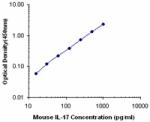- Clone
- TC11-8H4 (See other available formats)
- Regulatory Status
- RUO
- Other Names
- Interleukin-17, Cytotoxic T lymphocyte-associated antigen 8 (CTLA-8)
- Isotype
- Rat IgG1, κ
- Ave. Rating
- Submit a Review
- Product Citations
- publications
| Cat # | Size | Price | Quantity Check Availability | Save | ||
|---|---|---|---|---|---|---|
| 507005 | 100 µg | £185 | ||||
| 507006 | 1 mg | £449 | ||||
IL-17, also known as CTLA-8, is a T cell-expressed pleiotropic cytokine that exhibits a high degree of homology to a protein encoded by the ORF13 gene of herpes virus Saimiri. Recent study has shown that IL-17 is produced by Th cells (Th17) that are distinct from the traditional Th1- and Th2-cell subsets. IL-23 plays an important role in triggering IL-17 production. Both recombinant and natural IL-17 have been shown to exist as disulfide linked homodimers. IL-17 exhibits multiple biological activities on a variety of cells including: the induction of IL-6 and IL-8 production in fibroblasts; activation of NF-κB and costimulation of T cell proliferation. IL-17 is an essential inflammatory mediator in the development of autoimmune diseases. Neutralization of IL-17 with monoclonal antibody is able to ameliorate the disease course. The TC11-8H4 antibody antibody reacts with mouse interleukin-17 (IL-17).
Product DetailsProduct Details
- Verified Reactivity
- Mouse
- Antibody Type
- Monoclonal
- Host Species
- Rat
- Immunogen
- E. coli-expressed, recombinant mouse IL-17A
- Formulation
- 0.2 µm filtered in phosphate-buffered solution, pH 7.2, containing no preservative.
- Endotoxin Level
- Less than 0.01 EU/µg of the protein (< 0.001 ng/µg of the protein) as determined by the LAL test.
- Preparation
- The Ultra-LEAF™ (Low Endotoxin, Azide-Free) antibody was purified by affinity chromatography.
- Concentration
- The antibody is bottled at the concentration indicated on the vial, typically between 2 mg/mL and 3 mg/mL. Older lots may have also been bottled at 1 mg/mL. To obtain lot-specific concentration and expiration, please enter the lot number in our Certificate of Analysis online tool.
- Storage & Handling
- The antibody solution should be stored undiluted between 2°C and 8°C. This Ultra-LEAF™ solution contains no preservative; handle under aseptic conditions.
- Application
-
ELISA Detection - Quality tested
- Application Notes
-
ELISA2 and ELISPOT3 Detection: The biotinylated TC11-8H4 antibody is useful as a detection antibody for a sandwich ELISA assay, when used in conjunction with purified TC11-18H10 antibody (Cat. No. 506901) as the capture antibody, and with recombinant mouse IL-17 (Cat. No. 564101) as the standard.
-
Application References
(PubMed link indicates BioLegend citation) -
- Kennedy J, et al. 1996. J. Interferon Cytokine Res. 16:611.
- Herrada A, et al. 2010. J. Immunol. 184:191
- Nekrasova T, et al. 2005. J. Immunol. 175:2734.
- RRID
-
AB_2888884 (BioLegend Cat. No. 507005)
AB_2888884 (BioLegend Cat. No. 507006)
Antigen Details
- Structure
- Cytokine; dimer; 15 kD (Mammalian)
- Bioactivity
- Secretion of IL-6, IL-8, G-CSF, prostaglandin E2 by epithelial, endothelial or fibroblastic cells; stimulates cell migration, cord formation, and IL-6 secretion by stromal cells
- Cell Sources
- CD4+ memory T cells
- Cell Targets
- Fibroblasts, epithelial and endothelial cells, stromal cells
- Receptors
- IL-17R (CD217)
- Biology Area
- Cell Biology, Immunology, Neuroinflammation, Neuroscience
- Molecular Family
- Cytokines/Chemokines
- Antigen References
-
1. Fitzgerald K, et al. Eds. 2001. The Cytokine FactsBook. Academic Press San Diego.
2. Numasaki M, et al. 2002. Blood 101:2620.
3. Fossiez F, et al. 1996. J. Exp. Med. 183:2593.
4. Yao Z, et al. 1997. Cytokine 9:794.
5. Dong C. 2006 Nat. Rev. Immunol. 6(4):329.
6. Hofstetter HH, et al. 2005 Cell. Immunol. 237(2):123. - Gene ID
- 16171 View all products for this Gene ID
- UniProt
- View information about IL-17A on UniProt.org
Related FAQs
- Do you guarantee that your antibodies are totally pathogen free?
-
BioLegend does not test for pathogens in-house aside from the GoInVivo™ product line. However, upon request, this can be tested on a custom basis with an outside, independent laboratory.
- Does BioLegend test each Ultra-LEAF™ antibody by functional assay?
-
No, BioLegend does not test Ultra-LEAF™ antibodies by functional assays unless otherwise indicated. Due to the possible complexities and variations of uses of biofunctional antibodies in different assays and because of the large product portfolio, BioLegend does not currently perform functional assays as a routine QC for the antibodies. However, we do provide references in which the antibodies were used for functional assays and we do perform QC to verify the specificity and quality of the antibody based on our strict specification criteria.
- Does BioLegend test each Ultra-LEAF™ antibody for potential pathogens?
-
No, BioLegend does not test for pathogens in-house unless otherwise indicated. However, we can recommend an outside vendor to perform this testing as needed.
- Have you tested this Ultra-LEAF™ antibody for in vivo or in vitro applications?
-
We don't test our antibodies for in vivo or in vitro applications unless otherwise indicated. Depending on the product, the TDS may describe literature supporting usage of a particular product for bioassay. It may be best to further consult the literature to find clone specific information.
Other Formats
View All IL-17A Reagents Request Custom Conjugation| Description | Clone | Applications |
|---|---|---|
| Biotin anti-mouse IL-17A | TC11-8H4 | ELISA Detection,ELISPOT Detection |
| Ultra-LEAF™ Purified anti-mouse IL-17A Antibody | TC11-8H4 | ELISA |
Compare Data Across All Formats
This data display is provided for general comparisons between formats.
Your actual data may vary due to variations in samples, target cells, instruments and their settings, staining conditions, and other factors.
If you need assistance with selecting the best format contact our expert technical support team.

 Login / Register
Login / Register 











Follow Us